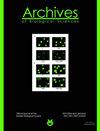Phytochemical composition of Verbascum stachydifolium Boiss & Heldr. var. stachydifolium growing in Türkiye and in vitro analysis of wound healing activity
IF 0.8
4区 生物学
Q4 BIOLOGY
引用次数: 0
Abstract
This study aimed to investigate the phenolic content, antioxidant activity, cytotoxicity and the in vitro wound healing activity of methanolic and aqueous extracts of Verbascum stachydifolium Boiss & Heldr. var. stachydifolium. Total phenolic and flavonoid contents and antioxidant activity were measured using spectrophotometry-based methods. Quantitative analysis of the selected phenolics was performed by HPLC. The cytotoxic effects of the extracts on L929 mouse fibroblast cells were evaluated by the MTT assay. The migration of treated fibroblast cells was assessed by the cell scratch assay. The expressions of type I collagen, FGF7, TGF-?1 and VEGF were evaluated by qRT-PCR and ELISA. The HPLC-based analysis revealed the presence of different phenolic compounds at varying amounts and high antioxidant activities were detected. The cytotoxicity assay results indicated that the methanolic and aqueous extracts did not exhibit any cytotoxic effect on fibroblast cells when used up to 500 ?g/mL concentration. Fibroblast migration was stimulated to the highest degree by the aqueous extract obtained by maceration as observed in the scratch assay at 60.4% closure. The molecular mechanism of the wound healing activity involves the upregulation of the analyzed genes.牡荆的植物化学成分研究。水仙在基耶生长及体外创面愈合活性分析
本研究旨在探讨水提物和水提物的酚类物质含量、抗氧化活性、细胞毒性和体外创面愈合活性。var. stachydifolium。用分光光度法测定总酚和类黄酮含量及抗氧化活性。采用高效液相色谱法对所选酚类物质进行定量分析。采用MTT法观察提取物对L929小鼠成纤维细胞的细胞毒作用。用细胞划痕法评价处理后成纤维细胞的迁移能力。I型胶原、FGF7、TGF-?采用qRT-PCR和ELISA法检测1、VEGF水平。高效液相色谱法分析表明,其含有不同数量的酚类化合物,具有较高的抗氧化活性。细胞毒性试验结果表明,当浓度达到500g /mL时,乙醇提取物和水提取物对成纤维细胞没有细胞毒性作用。在划痕实验中观察到,在60.4%闭合时,通过浸渍获得的水提取物可以最大程度地刺激成纤维细胞的迁移。伤口愈合活性的分子机制涉及所分析基因的上调。
本文章由计算机程序翻译,如有差异,请以英文原文为准。
求助全文
约1分钟内获得全文
求助全文
来源期刊
CiteScore
1.40
自引率
0.00%
发文量
25
审稿时长
3-8 weeks
期刊介绍:
The Archives of Biological Sciences is a multidisciplinary journal that covers original research in a wide range of subjects in life science, including biology, ecology, human biology and biomedical research.
The Archives of Biological Sciences features articles in genetics, botany and zoology (including higher and lower terrestrial and aquatic plants and animals, prokaryote biology, algology, mycology, entomology, etc.); biological systematics; evolution; biochemistry, molecular and cell biology, including all aspects of normal cell functioning, from embryonic to differentiated tissues and in different pathological states; physiology, including chronobiology, thermal biology, cryobiology; radiobiology; neurobiology; immunology, including human immunology; human biology, including the biological basis of specific human pathologies and disease management.

 求助内容:
求助内容: 应助结果提醒方式:
应助结果提醒方式:


